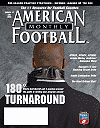AMERICAN FOOTBALL MONTHLY THE #1 RESOURCE FOR FOOTBALL COACHES
Article CategoriesAFM Magazine
|
The Drills Report: Georgia\'s Offensive Blocking Circuitby: Wayne Anderson© More from this issue This month’s drill has been submitted by Coach Neil Callaway, the Offensive Coordinator and Offensive Line Coach of the 2005 SEC Champion Georgia Bulldogs. Since Coach Callaway became a member of coach Mark Richt’s staff in 2001, the Bulldogs have won two SEC Championships, three bowl victories and three top six finishes in the final polls. Coach Calloway explains his blocking circuit: “We implemented the Blocking Circuit at the University of Georgia after the 2003 season. The reason was twofold: first was to try to stress the importance of toughness and secondly that everybody on offense takes great pride in blocking. During spring practice and early fall we will do this drill pretty much every day, even in shorts we will do the drill versus bags for ten minutes....The full article can only be seen by subscribers. Subscribe today!
|
|
|||||||
| HOME |
MAGAZINE |
SUBSCRIBE | ONLINE COLUMNISTS | COACHING VIDEOS |
Copyright 2025, AmericanFootballMonthly.com
All Rights Reserved





